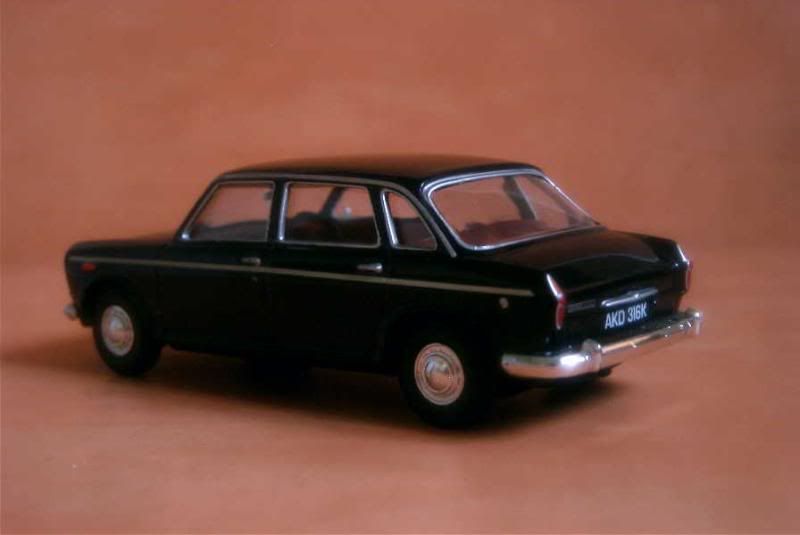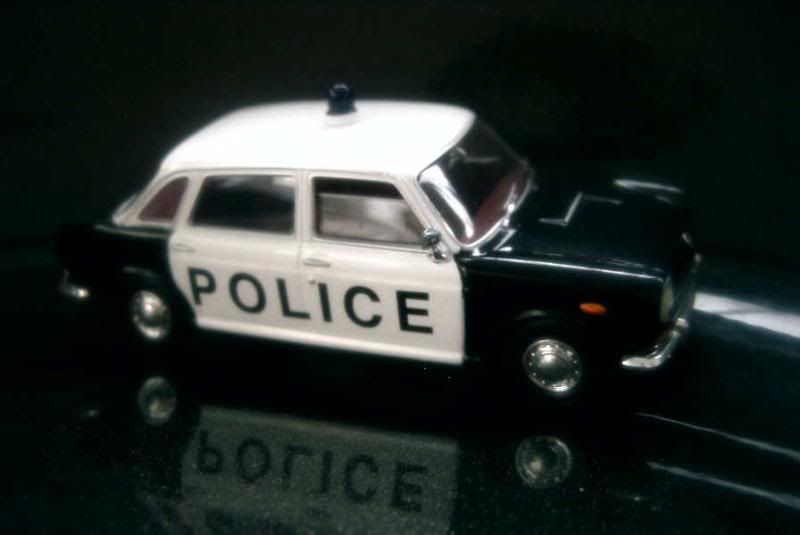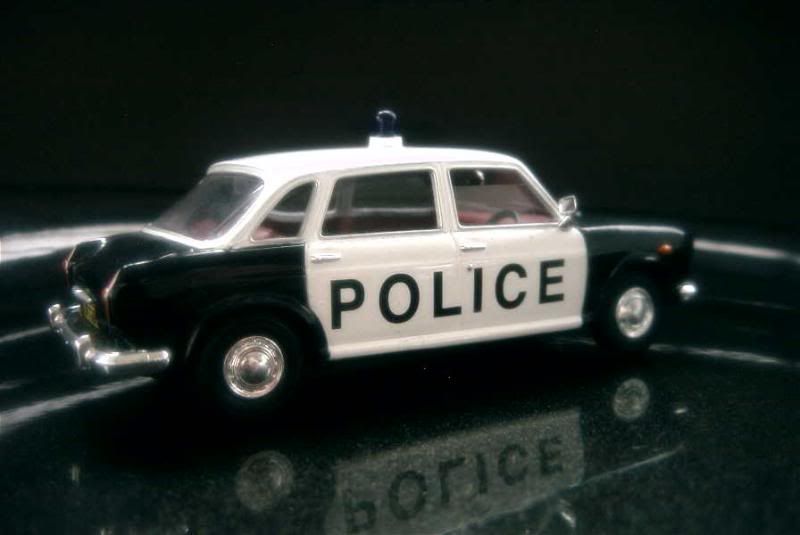A little history
Shortly before the merger that would create the unfortunate British Leyland conglomerate, BMC was still a very successful carmaker. The company had released the Mini, then the 1100, two very strong sellers on the home market and, at least for the former, in foreign lands. BMC’s staff supposed that the basic recipes which had make these cars the hits they were could be applied throughout the range. This is how the ADO 17 was born.
The larger family saloons offered by BMC had been rather conventional up to then. When introduced, the ADO 17 proposed an incredibly roomy passenger compartment - thanks to the fact that it had all four wheels pushed to its corners -, front-wheel-drive and Hydrolastic suspension. Even with the help of Pininfarina, Alec Issigonic seems to have struggled to make the car presentable: it appeared as a ridiculously outgrown Mini, not exactly the kind of things BMC’s conservative customers wanted to be seen riding in.
The ADO 17 was unveiled in September 1964 as the 4-cylinder Austin 1800 and 6-cylinder Austin 2200. Despite its many qualities (comfort, handling, extreme structural rigidity), the car’s look played against it. While the Austin 1800 received the coveted European Car of the Year award in 1965, its sales were disappointing and it soon gained the ungraceful nickname “landcrab”.
Morris stuck for a time to the conventional Oxford model, but an ADO 17-based replacement was scheduled for it too. It appeared in 1966 as the Morris 1800 and 2200. During the following year, the Wolseley 18/85 and Six were launched, featuring higher quality standards and the traditional Wolseley front grille, but few other differences whatsoever. An automobile’s development spanning years, BMC was the victim of its programs’ inertia and the same mistakes were repeated again in the 3-Litre, its new top-of-the-line saloon presented at the London motor show in October 1967. Despite the fact that it retained a traditional rear-wheel-drive transmission, the 3-Litre inherited the central section of the ADO 17 and its Hydrolastic suspension arrangement – it ended in complete disaster and was soon removed from the market.
Another failure was to adapt the car to the Australasian market. After producing a virtually unchanged ADO 17 in Australia, two heavily modified Austin Tasman and Morris Kimberley were introduced in 1970. Unsurprisingly, the technologically refined cars couldn’t do much in a country which liked antiquated, American-style gas-guzzlers. These models disappeared in 1974, shortly before the British company’s Australian operations were definitely closed down.
If the luxury 3-Litre had been scuttled early on, BMC didn’t have such an easy way out with its more mainstream ADO 17. The company did what it could to improve the car, facelifting it in 1968 (Mark II version), adding further modifications in 1972 (Mark III), and trying to address the quality problems that were beginning to plague the British motor industry. All its efforts were to no avail. The whole ADO 17 range was retired in March 1975, when the wedge-shaped Princess on which rested most of BLMC’s hopes was introduced.
About the models
Model: Austin 1800 Mark II
Year: 1968
Maker: Corgi
Scale: 1/43
Distributed by: Vanguards
Acquired: brand new, in February 2008, in Manila, Philippines.
A very acceptable model of the Austin 1800. Rear lights are simply painted, but it’s so nicely done that no one will probably mind. The front end’s rendition is excellent. A Vanguards’ touch is the photo-etched wipers, a rarity in this price range. My rating is 13/20.


Model: Austin 1800 Mark II
Year: 1968
Maker: Corgi
Scale: 1/43
Distributed by: Vanguards
Acquired: brand new, in August 2007, through a friend from Shanghai, China.
Same model as the above, with a different decoration: 13/20 again.


Shortly before the merger that would create the unfortunate British Leyland conglomerate, BMC was still a very successful carmaker. The company had released the Mini, then the 1100, two very strong sellers on the home market and, at least for the former, in foreign lands. BMC’s staff supposed that the basic recipes which had make these cars the hits they were could be applied throughout the range. This is how the ADO 17 was born.
The larger family saloons offered by BMC had been rather conventional up to then. When introduced, the ADO 17 proposed an incredibly roomy passenger compartment - thanks to the fact that it had all four wheels pushed to its corners -, front-wheel-drive and Hydrolastic suspension. Even with the help of Pininfarina, Alec Issigonic seems to have struggled to make the car presentable: it appeared as a ridiculously outgrown Mini, not exactly the kind of things BMC’s conservative customers wanted to be seen riding in.
The ADO 17 was unveiled in September 1964 as the 4-cylinder Austin 1800 and 6-cylinder Austin 2200. Despite its many qualities (comfort, handling, extreme structural rigidity), the car’s look played against it. While the Austin 1800 received the coveted European Car of the Year award in 1965, its sales were disappointing and it soon gained the ungraceful nickname “landcrab”.
Morris stuck for a time to the conventional Oxford model, but an ADO 17-based replacement was scheduled for it too. It appeared in 1966 as the Morris 1800 and 2200. During the following year, the Wolseley 18/85 and Six were launched, featuring higher quality standards and the traditional Wolseley front grille, but few other differences whatsoever. An automobile’s development spanning years, BMC was the victim of its programs’ inertia and the same mistakes were repeated again in the 3-Litre, its new top-of-the-line saloon presented at the London motor show in October 1967. Despite the fact that it retained a traditional rear-wheel-drive transmission, the 3-Litre inherited the central section of the ADO 17 and its Hydrolastic suspension arrangement – it ended in complete disaster and was soon removed from the market.
Another failure was to adapt the car to the Australasian market. After producing a virtually unchanged ADO 17 in Australia, two heavily modified Austin Tasman and Morris Kimberley were introduced in 1970. Unsurprisingly, the technologically refined cars couldn’t do much in a country which liked antiquated, American-style gas-guzzlers. These models disappeared in 1974, shortly before the British company’s Australian operations were definitely closed down.
If the luxury 3-Litre had been scuttled early on, BMC didn’t have such an easy way out with its more mainstream ADO 17. The company did what it could to improve the car, facelifting it in 1968 (Mark II version), adding further modifications in 1972 (Mark III), and trying to address the quality problems that were beginning to plague the British motor industry. All its efforts were to no avail. The whole ADO 17 range was retired in March 1975, when the wedge-shaped Princess on which rested most of BLMC’s hopes was introduced.
About the models
Model: Austin 1800 Mark II
Year: 1968
Maker: Corgi
Scale: 1/43
Distributed by: Vanguards
Acquired: brand new, in February 2008, in Manila, Philippines.
A very acceptable model of the Austin 1800. Rear lights are simply painted, but it’s so nicely done that no one will probably mind. The front end’s rendition is excellent. A Vanguards’ touch is the photo-etched wipers, a rarity in this price range. My rating is 13/20.


Model: Austin 1800 Mark II
Year: 1968
Maker: Corgi
Scale: 1/43
Distributed by: Vanguards
Acquired: brand new, in August 2007, through a friend from Shanghai, China.
Same model as the above, with a different decoration: 13/20 again.





No comments:
Post a Comment